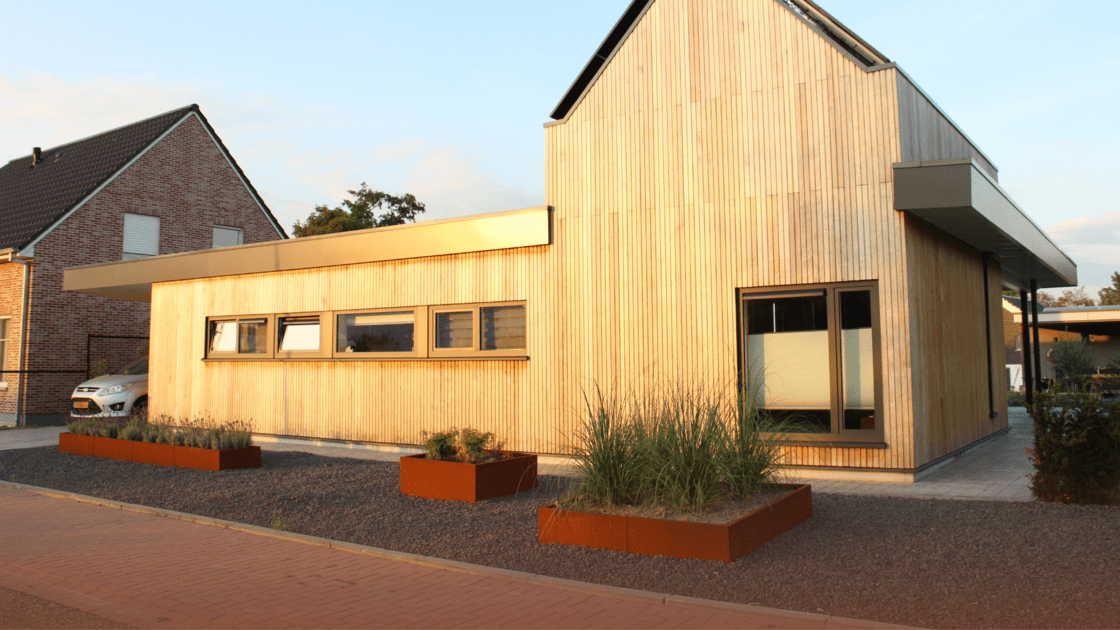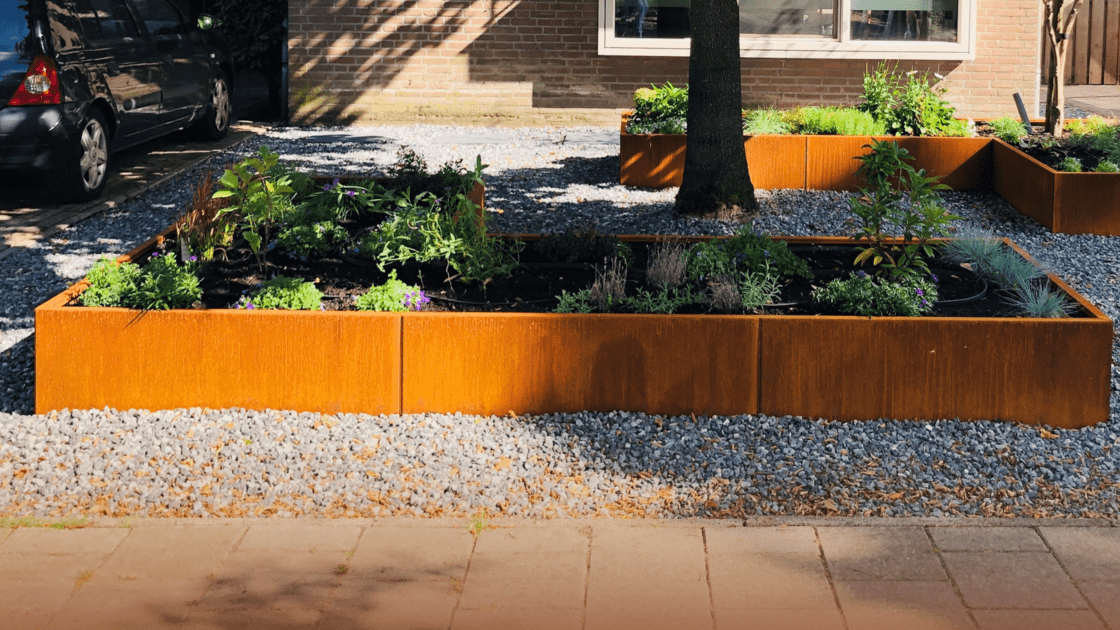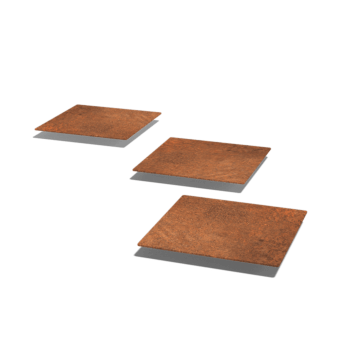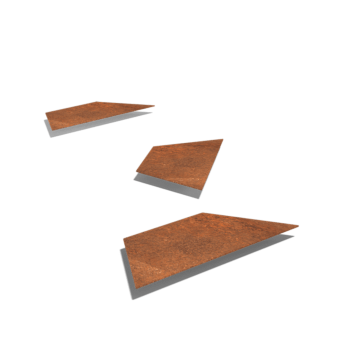Which plants fit best around stepping stones?
Stepping stones are a handy and beautiful addition to your garden. They not only create a practical walkway but also look good. Especially stepping stones made of corten steel are popular due to their unique and modern appearance. By choosing the right plants around your stepping stones, you ensure a beautiful and cohesive garden.
In this blog, we will delve into which plants fit best around stepping stones. This way, you can soon make your garden even more attractive.
Summary
- The right planting around stepping stones creates an attractive and cohesive garden.
- Ground covers like creeping thyme, sedum, and mosses are ideal between the stones.
- Ornamental grasses like fescue, blue sheep's fescue, and golden reed accentuate the edges of the stepping stones.
- Small perennials like lavender, violets, thyme, and campanula add color and fragrance along the paths.
Planting around the stepping stones
Planting around your stepping stones can give your garden a completely different appearance. With the right plants between and beside the stones, you create a beautiful and practical transition. Here we discuss some of the best choices, such as ground covers, ornamental grasses, and small perennials.
Reading Tip
Do you want to know how to lay stepping stones in your garden yourself? Read our blog ‘Laying Corten Steel Stepping Stones in the Garden: How Do You Do That?’
Ground covers: perfect between the stepping stones
Ground covers are ideal for filling the space between stepping stones. They provide a green and lively garden, give stability, and prevent erosion. These low plants grow quickly and nicely fill the space.
| Ground Cover | Growth Height | Color | Maintenance |
| Creeping Thyme | 5-15 cm | Green with purple, pink, or white flowers | Low maintenance; pruning after flowering is recommended |
| Sedum (Stonecrop) | 5-20 cm | Green with various shades, yellow, pink, or red flowers | Very low maintenance; drought-resistant |
| Mosses | 1-5 cm | Various shades of green | Low maintenance; needs moist conditions |
Creeping Thyme
Creeping thyme is a popular ground cover in many gardens due to its versatility and beautiful appearance. The colored flowers of creeping thyme also match beautifully with corten steel stepping stones. They create a lovely contrast with the rusty, orange-brown tones of the corten steel.
Here are some advantages of creeping thyme:
- Low-growing: Creeping thyme grows low, usually between 5 and 15 cm, and spreads easily. This is perfect for filling the narrow spaces between stepping stones, allowing the stones to remain visible while keeping the gaps green and full.
- Pleasant fragrance: Walking on it releases a delightful scent. This adds an extra delightful experience to your garden, especially on warm days.
- Colorful blooming: Creeping thyme blooms with small flowers in purple, pink, or white. These flowers add extra color to your garden and contrast beautifully with the stones and other plants.
- Attracts pollinators: The flowers of creeping thyme attract bees and other beneficial insects. This is good for the various plants and animals in your garden and helps keep your garden healthy.
- Low maintenance: This plant is drought-resistant and requires little maintenance. You only need to prune it occasionally to prevent it from overgrowing. Therefore, creeping thyme is an excellent choice for people who want a beautiful yet easy-to-maintain garden.
“Are you looking for plants that are ideal for filling the space between stepping stones? Consider ground covers like creeping thyme, sedum, and mosses.”
Sedum (Stonecrop)
Sedum, also known as stonecrop, is a easy-to-grow plant often used as ground cover in gardens. Stonecrop adapts well and looks beautiful with its various colors.
Here are some advantages of sedum:
- Low and spreading growth: Sedum stays low to the ground (5-20 cm) and spreads quickly. This makes it perfect for filling the space between stepping stones and ensures a dense, green cover.
- Water storage in leaves: Sedum is a succulent and stores water in its leaves. This allows it to tolerate drought well, making it ideal for dry and sunny spots.
- Colorful: Sedum comes in many colors such as green, red, and yellow. This variety creates a vibrant and appealing ground cover and brings more color to your garden.
- Flowering plant: Sedum produces small flowers in various colors (yellow, pink, red). These flowers add extra color to the garden and attract pollinating insects as well.
- Low maintenance: This ground cover requires little care, grows well in poor soil, and needs little water.
Mosses
Mosses are easy to maintain and grow well in places where other plants struggle. Additionally, they look beautiful with corten steel stepping stones. The green and soft appearance of mosses provides a nice, subtle contrast to the hard, industrial look of corten steel.
Below are some of the main advantages of using mosses as planting around your stepping stones:
- Low growth: Mosses grow only a few centimeters high (1-5 cm) and form a soft, dense layer between your stones.
- Always green: Mosses remain vibrantly green all year round. This keeps your garden looking fresh and attractive at all times.
- Grows well in shade: Mosses thrive in shady and moist environments. They are perfect for areas where other plants do not grow well, such as under trees.
- Low maintenance: Mosses do not need to be pruned and require little maintenance. Ideal if you have little time to take care of your garden.
- Stable garden: They help stabilize the soil and prevent erosion between the stones, contributing to a sustainable and stable garden.
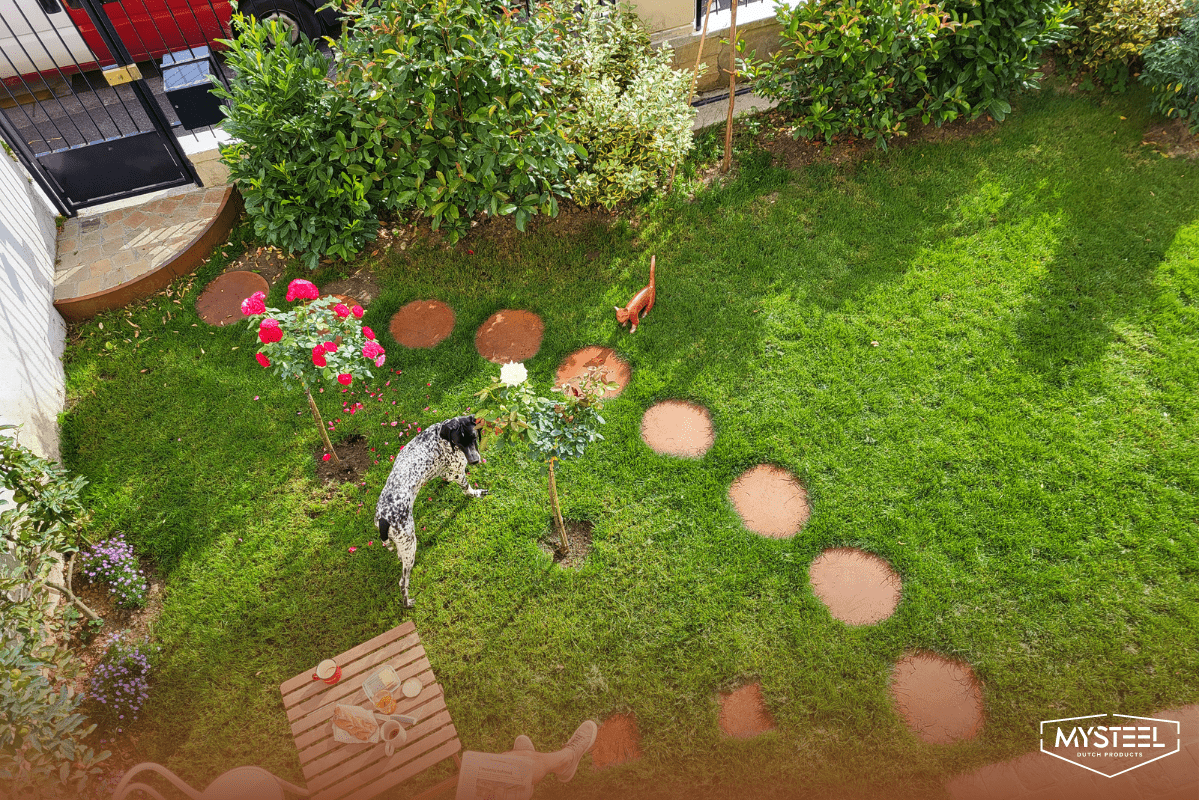

Ornamental Grasses: Accentuate the Stepping Stones
Ornamental grasses are perfect to place next to stepping stones, but not so suitable for the walkway itself. By planting ornamental grasses next to the stepping stones, you can create a beautiful transition to the rest of your garden. This makes your walkway even more attractive to look at.
| Ornamental Grass |
Growth Height | Color | Maintenance |
| Fescue | 30-60 cm | Green, blue-green | Low maintenance; regular pruning to maintain shape |
|
Blue Sheep's Fescue |
15-30 cm | Bluish-green | Very low maintenance; drought-resistant |
| Golden Reed | 120-250 cm | Green with ornamental plumes that can be red, silver, or purple | Moderate maintenance; pruning in early spring |
Fescue
Fescue is an ornamental, rounded grass commonly used in gardens and along paths. It is known for its beautiful rounded appearance and easy maintenance.
Here are a few advantages of fescue:
- Easy to maintain: Fescue requires little care, which is ideal for people with a busy schedule. After planting, it only needs occasional water and attention.
- Beautiful leaves: The fine, elegant leaves of fescue give garden paths a soft look. They sway beautifully in the wind, making your garden look even prettier and more vibrant.
- Green color: This grass stays green throughout the season, providing a fresh and vibrant appearance along the paths. This keeps your garden looking well-groomed.
- Resistant to various weather conditions: Fescue can withstand various weather conditions, such as drought and light shade.
Blue Sheep's Fescue
Blue sheep's fescue is a great plant to enhance your garden. It has many advantages that make it a good choice for any garden:
- Striking color: This grass has a unique blue-green hue that provides a beautiful variation in your garden. The color attracts attention and adds extra charm to your garden. Moreover, it offers a striking contrast to the rusty brown tones of corten steel stepping stones.
- Small, neat growth: This plant remains low and grows in compact clumps, making it perfect for the edges of your garden path.
- Cold-resistant: This grass withstands cold well and retains its beautiful color and shape throughout the year. This means your garden looks stunning even in winter.
- Requires little water: Blue sheep's fescue needs little water and is perfect for sunny spots. This makes it a low-maintenance choice that thrives in dry conditions.
“Ornamental grasses are ideal for planting next to stepping stones and create a smooth transition to the rest of your garden.”
Golden Reed
Golden reed is a popular ornamental grass in gardens. It adds height and movement to your garden and is easy to maintain.
Here are some advantages of golden reed:
- Height and structure: Golden reed grows tall and creates an impressive look. It creates different levels in your garden, giving a beautiful visual effect.
- Decorative plumes: The ornamental plumes sway gently in the wind, bringing life and dynamics to your garden. The elegance of the plumes also pairs well with corten steel stepping stones as they contrast beautifully with the industrial look of the steel.
- Seasonal color change: Golden reed changes color throughout the year: fresh green in spring and summer, and gold and brown in autumn and winter.
- Simple maintenance: Apart from an annual pruning, golden reed requires little care.
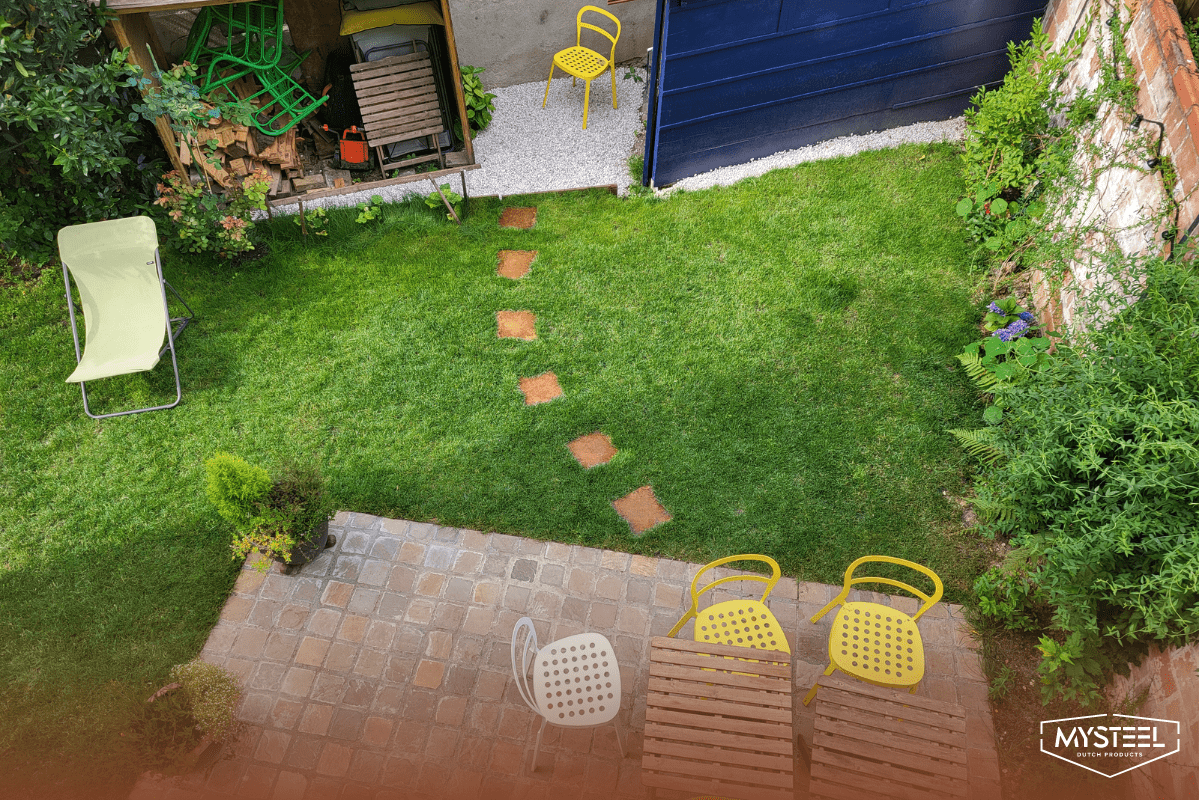

Small Perennials: Plants Around the Pathway
Small perennials are ideal for placing around your pathway. They add color and help the pathway blend beautifully into the rest of the garden. This creates a harmonious whole that invites you to stroll through the garden.
| Perennial | Growth Height | Color | Maintenance |
| Lavender | 30-60 cm | Green with purple, pink, or white flowers | Low maintenance; pruning after flowering to maintain shape |
| Violets | 10-25 cm | Green with flowers in various colors (purple, yellow, white, blue) | Moderate maintenance; regularly removing faded flowers |
| Thyme | 5-15 cm | Green with small pink or purple flowers | Low maintenance; drought-resistant |
| Campanula | 15-30 cm | Green with blue, purple, or white bell-shaped flowers | Moderate maintenance; pruning after flowering to promote new growth |
Lavender
Lavender is a popular plant due to its beautiful flowers and delightful fragrance. Moreover, lavender is not only beautiful but also has many advantages for your garden:
- Delightful fragrance: Lavender smells nice and makes the path pleasant. You can also use the flowers to make sachets, for example.
- Requires little water: Lavender tolerates drought well. You don't need to water much, which is convenient for dry and sunny spots.
- Beautiful flowers: The purple flowers of lavender provide a lovely color along the path.
- Insect-repelling: Lavender keeps annoying insects away. This means fewer issues with mosquitoes and other pests.
Violets
Violets are beautiful flowers that brighten up your garden. They are easy to care for and bloom in various seasons. Here are the benefits of violets:
- Colorful: Violets come in many colors, including purple, yellow, white, and blue. They make your garden path lively and beautiful.
- Compact growth: They stay low and grow neatly along the edges of your pathway without becoming invasive.
- Seasonal blooming: Violets bloom in early spring and autumn, providing color across multiple seasons.
- Easy to care for: These colorful plants require little maintenance; you only need to occasionally remove the faded flowers.
“With corten steel stepping stones and well-chosen plants, you can make your garden beautiful and practical.”
Thyme
Thyme is a robust plant that grows small and low and has beautiful flowers. This makes your garden always look neat and well-groomed. Additionally, this small plant has even more advantages for your garden:
- Ground cover: Thyme grows dense and compact, stopping weeds and keeping your path tidy.
- Beautiful flowers and fragrance: The small pink or purple flowers emit a pleasant scent and provide a lovely contrast with the green leaves.
- Requires little water: Thyme withstands drought well and needs little water. Therefore, it’s easy to maintain.
- Good for bees and butterflies: The flowers of thyme attract bees and butterflies. This is great for biodiversity and the ecosystem in your garden.
Campanula
The campanula is a popular plant in many gardens. This plant has beautiful flowers and grows easily. Therefore, campanula is ideal for everyone, whether you are just starting gardening or have a lot of experience.
- Long-lasting bloom: Campanula blooms for a long time with beautiful bell-shaped flowers in blue, purple, and white. This keeps your garden colorful and lively for a longer time.
- Low-growing: Due to its low and compact growth, campanula is ideal for the edges of paths. They grow neatly without overtaking other plants.
- Winter-hardy: Campanula withstands cold and comes back every year. This means you don't have to replant every spring and can still enjoy beautiful flowers.
- Graceful appearance: The bell-shaped flowers give a playful and attractive look to your garden. They create a beautiful contrast with other plants, making your garden even more interesting.
Conclusion
It is essential to choose the right planting around your stepping stones. There are various options available. Ground covers are perfect for between the stones, while ornamental grasses provide a nice accent along the edges. Small perennials like lavender and violets add color and fragrance.
By selecting your plants wisely and combining them with corten steel stepping stones, you can create a beautiful and functional garden. The warm, rusty-brown color of corten steel gives your garden a natural and modern appearance. The durable material can withstand various weather conditions and is easy to maintain. Corten steel stepping stones also provide a sturdy and safe pathway through your garden.
Moreover, it is not difficult to do this yourself. With some planning and creativity, you can easily lay your own garden path! Get started and transform your garden into a unique place you can be proud of.




